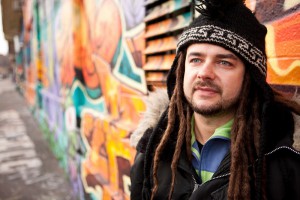Friday
Featured StoriesExploring Receptivity
COLUMN: Radical Compassion
Interview with Adam Bucko
conducted by Cameron Wenaus of retreat.guru and Sarah Lipton, Editor-in-Chief of the Shambhala Times
transcribed by Emma Sartwell, edited by Christopher Schuman
It can be difficult to find a place of receptivity in prayer and meditation. But once we do, how do we bring that quality of openness with us back into the world?
We recently sat down with Adam Bucko over Skype and had an engaging dialogue about contemplative practice and the importance of receptivity. In this warm conversation with the co-founder of the Reciprocity Foundation, we dug into this looming question.
Being both receptive and spiritually active often feels challenging. In our conversation, Adam expressed it beautifully, “For me, contemplative activism is essentially about how to live in such a way that God can live through me as much as possible.”
In this way, Bucko describes a practice through which we tap into our receptivity, bringing our experience of God with us. We do not push that presence away, but allow it to linger. We begin to investigate how we switch from receptivity in our practice to action in our lives.
But how do we reach this receptivity, we wondered?
Adam shared his own practice as an example. “The primary silent contemplative practice that I do is based on the Centering Prayer method taught by Father Thomas Keating, among others.” As Adam explained, “It’s a receptive method that comes out of the Christian tradition. The way it works as a receptive method is, essentially, that you open and put yourself into a state of receptivity and listening. You open yourself to what, in the Christian tradition, is called the guidance of the Holy Spirit.”
This resonates explicitly to the Christian experience, but receptivity is definitely a deep part of all practice. “The way that I experience it, and it’s really the core of my life, is to be in that state where I can begin to sense the arising of what I call God’s ‘impulse’ in my heart, and then the work is to say yes to it, and to let it live through me.”
Bucko asserts that this “yes” is an act of internal activism. We can begin by looking at how we experience God within ourselves, which does not seem all that different from how we connect with our genuine hearts and minds on a meditation cushion in a non-theistic tradition.
“I think that in our contemplative traditions, we often like to say that the internal part of activism is the first requirement. Many of us then even say, well, you know, once I reach a certain level of realization, then I’m going to engage in action.”
Adam was interested in this internal activism and wound up traveling to India to study with Hindu-Christian monks. “I kind of wanted to discover God in the Himalayas,” he told us. However, what he discovered there was quite different than he thought it would be. “On the way to the monastery, I wound up meeting a homeless kid and that kind of crashed my whole plan. Eventually I moved into another ashram that was located in the slums of Delhi so I could be closer to the world”What changed for Bucko? “I thought I would dive into contemplative practice through spiritual pursuit, but I discovered contemplative experience through action instead.” Even though he spent quite a few years doing internal work, “my initial sense of what contemplation is about actually didn’t come from that,” Bucko told us. “It came from action, through which I began discovering moments of presence in that state where the distinction between action and contemplation disappears.”
This is helpful because so much of one’s path can be removing that line between inner and outer and not seeing a separation. “I do think that the years of practice that I put in definitely played a role in my experience. But at this point, I almost don’t like to make a distinction between inner work and outer work because my experience of action is essentially an experience that I have in my Centering Prayer.”
Receptivity must come first. But once achieved, the practice turns into how to bring your understanding out into the world of action. There is no distinction between prayer and action. They are two parts of one full practice.
~~
See more articles in the Radical Compassion Column.
Learn more about Adam Bucko.
Learn more about Retreat.Guru.
Learn more about Naropa University who hosted the Radical Compassion Symposium and inspired us to pursue these interviews.


















